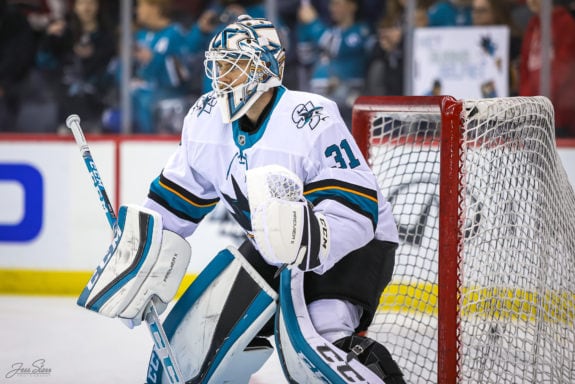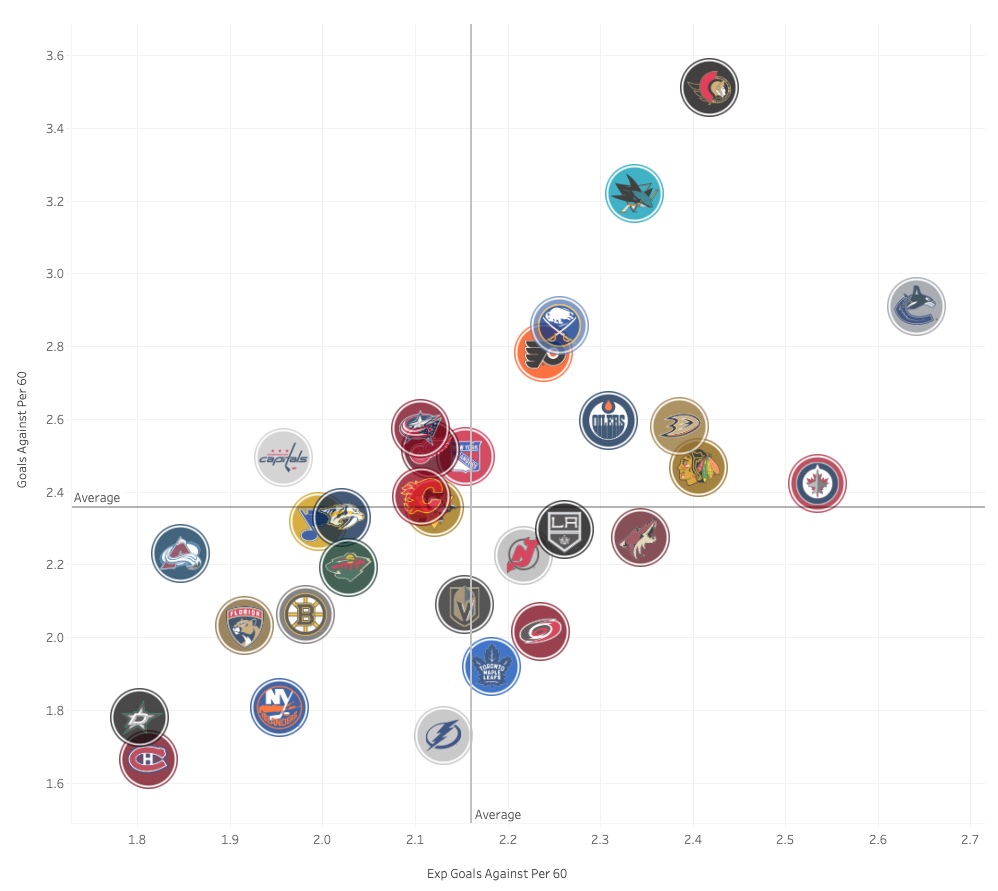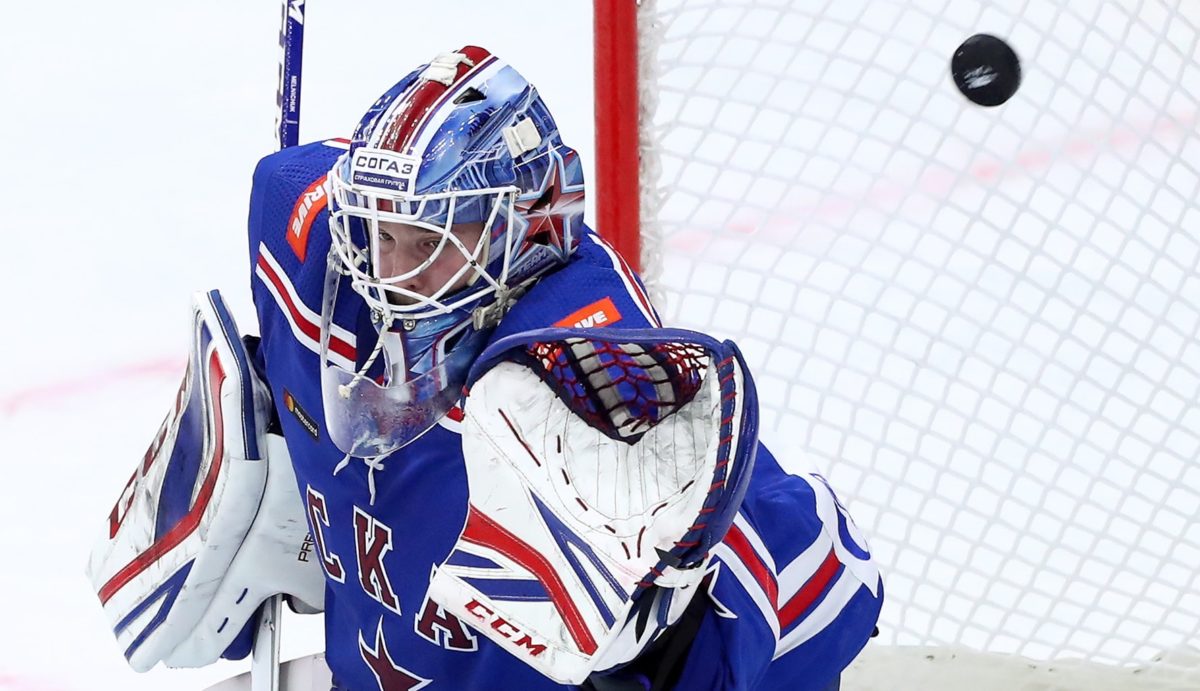The San Jose Sharks currently sit last in the Honda West Division with 21 points in 23 games played. They are ahead of the Anaheim Ducks via points percentage and have played fewer games than everyone else in the division except the Vegas Golden Knights. When analyzing the reasons they are doing so poorly, the goaltending is a clear issue that pops out. After the first eight games, things were a bit uncertain, but after a larger sample size, the blemish in the crease is clearly in focus. I’ll examine the state of the Sharks’ goaltending and offer suggestions moving forward.
No Clear Starter
Martin Jones and Devan Dubnyk were expected to share starts this season with the theory that one would take the reins and become the 1A. So far, the results are very underwhelming for both. This season, Dubnyk is 51st and Jones is 60th out of 61 goaltenders who have played at least five games in the metric of save percentage. It’s pretty hard to win games if you have quite literally two of the worst goalies in the league.

According to Evolving Hockey, both Jones and Dubynk are doing terribly when correcting for the workload and difficulty of shots they face. Jones has saved 11 goals fewer than expected in his 15 appearances. Dubnyk is only slightly better at nine fewer than expected. Jones is similarly bad in goals saved above average (GSAA), which compared him to what other goalies would do in the same situation, where he has given up 11 more goals than average. Dubnyk is much better in this metric at a minus-3.6 GSAA. Both have a strongly negative delta Fenwick save percentage, which corrects for the protection offered to them by the team.
Expecting More
What’s especially frustrating for the Sharks’ situation is that their expected goals against is better this season than last. In 2020-21, the Sharks are 23rd in expected goals against per 60 minutes, about a quarter of a goal better than in 2019-20. That indicates they are close to being in the middle third of defensive teams. Not great by any means, but if they have even average goaltending, they should be closer to a bubble playoff team.

Instead, as you can see from the graphic above from Dobber Hockey’s Frozen Tools, the Sharks are giving up way more goals than they should be, based on expected goals metrics. This we can definitely blame on the goalies. When there is this much of a mismatch between what the expected and actual goals against are, the blame has to fall mainly on the goaltenders.

Of course, it would help if the Sharks could score more – that might hide some of their goaltending issues. They are 18th in expected goals for per 60 minutes, but only clock in at 22nd in terms of actual goals scored in the league. Their combined shooting and save percentage of 970 (also known as PDO), courtesy of Hockey-Reference suggests they have been very unlucky. If that regresses to 1000, as it usually does, they should get a few more goals.
So What To Do?
It seems like the experiment with Martin Jones as the No. 1 goaltender has proven to be a resounding failure. Sure, there were a couple of good years where he was serviceable, but it hasn’t been the case for at least the last few seasons. He is more of a liability to lose the game than to help win it now.
Unfortunately, the Sharks are committed to Jones for three more seasons after this one at the hefty salary-cap hit of $5.75 million. Their options would be to waive him and hope someone claims him (unlikely) or buy him out in the offseason. At least if they waive him, they could put him on the taxi squad and see what they have in Josef Korenar and Alexei Melnichuk. The Sharks will almost certainly expose him in the Seattle Kraken Expansion Draft.
Dubnyk Should Get a Longer Leash
Dubnyk is a free agent after this season. The Sharks should give him a longer look as a No. 1 goalie to see what they should do in the offseason. He’s certainly been a capable goalie in the league before, but it’s unclear what he still brings to the table. If they are considering re-signing him, they probably need a larger sample size of games to make an informed decision.
Melnichuk Time
In terms of internal options, there is a lot of excitement for Melninchuk, and for good reason. After several great seasons in the SKA St. Petersburg system, he spent 14 games this fall on loan to Torpedo Nizhny Novogorod. In those appearances, he managed a 2.68 goals-against average (GAA) and .912 save percentage (SV%). That may not sound as impressive as his 2.05 GAA and .930 SV% in his last 16 games for SKA, but Torpedo is a far inferior team to SKA.

So far, he has appeared in six games for the San Jose Barracuda of the AHL and has a 3.16 GAA and .877 SV%. This shouldn’t discourage fans, as these are his first games on North American soil. He did appear in one NHL game in relief of Jones on Feb. 11, where he stopped all five shots he faced in the 6-2 loss to the Los Angeles Kings. Melnichuk is one of the best goalie prospects out there and deserves a shot sooner than later.
In fact, the Sharks should give him a shot now. If they find he can handle starter duties or at least be in a timeshare, that will dramatically change what they might do at the trade deadline or in the offseason. Without knowing what he can handle, they might mistakenly sign another goalie and push him down the depth chart. As can be seen from this viz from Hockey Prospecting, Melnichuk is not terribly dissimilar to Igor Shesterkin. They both started in the same SKA system and then ventured to North America. Shesterkin certainly had a higher pedigree and international experience, but it seems time we figured out exactly how good Melnichuk is. My bet is firmly on the side of he’s very, very good.
Will They Wallstedt?
The Sharks have never in their history taken a goalie in the first round. In fact, they have never taken a goalie in the second round. Their highest selection for a goalie has been the third, which they have matched three times with Terry Friesen in 1996, Thomas Greiss in 2004, Timo Pielmeier in 2007, and Mike Robinson in 2015. With the exception of Greiss, none of those goalies made an impact and it wasn’t until Greiss left San Jose that he left his mark in the NHL.
The 2021 draft does not have a consensus top skater. There are a lot of good defenders in this draft, but the lack of a generational talent makes the decision of who to take a little more subjective. While I’m not a fan of drafting for positional need, Jesper Wallstedt is one of the best goalie prospects in a long time. His equivalency via Hockey Prospecting is higher in this draft year than both Yaroslav Askarov and Spencer Knight.
Not that Wallstedt will be better than previous first-round goalie picks, but what he is already doing at the SHL level is impressive. With the Sharks having a long track record of substandard goaltending, it might behoove them to take the best goalie prospect in a long time. Will they do it? Doubtful. The Sharks track record seems to suggest they’d rather use late picks, or wait and sign an undrafted goalie (like Melnichuk, Jones, and Korenar).
The Time is Now
The Sharks need to make some serious decisions about their goaltending. They need to stop pretending they are contenders for the Stanley Cup and look to the future. They have a potential starter already in Melnichuk and a potential 1B in Korenar. The time is now to see what these guys have to offer – we already know what Jones has to offer, and it isn’t good. I still hold some hope for a Dubnyk resurgence, but Jones needs to be out of the way for that to happen.